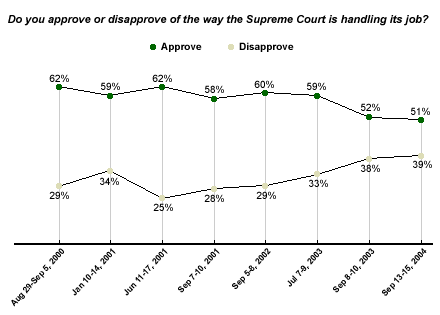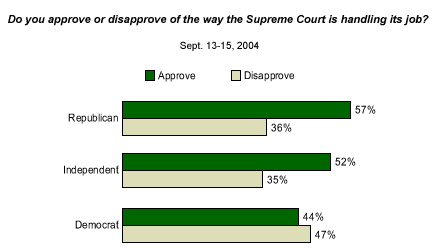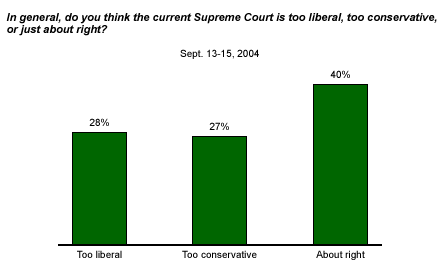The stakes in the 2004 presidential election were considered higher than normal for many reasons, not the least of which is that the winner would likely nominate at least one new Supreme Court justice, if not more, over the next four years. Chief Justice William Rehnquist, 80, is battling thyroid cancer, and the average age of all the current court justices is 70.
Now that the election is over, with George W. Bush elected to a second term, much of the talk in political circles last week revolved around whom Bush might nominate for the court, and how the Democrats might react to that nomination. Recent Gallup polling illustrates what Americans think of the job the Supreme Court is doing, and how they feel about the court from an ideological standpoint.
Supreme Court's Favorable Rating Holds Steady
Gallup's September 2004 Governance poll*, conducted after the close of the Supreme Court's 2003 term and before news broke about Rehnquist's illness, shows that half (51%) of Americans approve of the way the Supreme Court is handling its job. Roughly 4 in 10 (39%) disapprove, while 10% have no opinion. These results are consistent with findings from a year ago, but the percentage who approve of the Supreme Court has tailed off compared with polls from 2000 to July 2003.

Opinion of the way the Supreme Court is handling its job varies somewhat by partisanship. A majority of Republicans (57%) approve, compared with 52% of political independents and just 44% of Democrats. Support among all these groups has eroded since a high approval rating of 62% in June 2001.

The Conservative Question
Democrats' disapproval of the Supreme Court probably reflects their belief that the justices are too conservative. Half of Democrats (51%) believe the court is too conservative, while nearly half of Republicans (48%) believe it is too liberal. Overall, Americans are most likely to say they favor the court's ideological makeup. A plurality -- 40% -- thinks the court is "about right," while 27% believe it is too conservative, and 28% believe it is too liberal.

*These results are based on telephone interviews with a randomly selected national sample of 1,022 adults, aged 18 and older, conducted Sept. 13-15, 2004. For results based on this sample, one can say with 95% confidence that the maximum error attributable to sampling and other random effects is ±3 percentage points. In addition to sampling error, question wording and practical difficulties in conducting surveys can introduce error or bias into the findings of public opinion polls.
